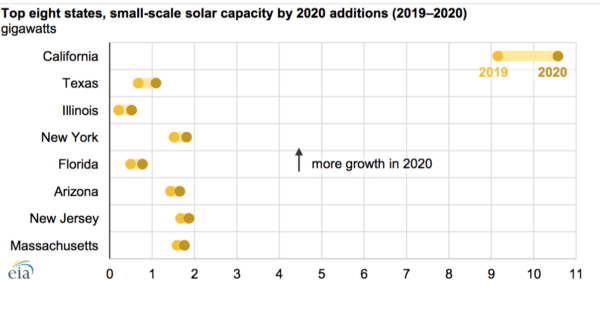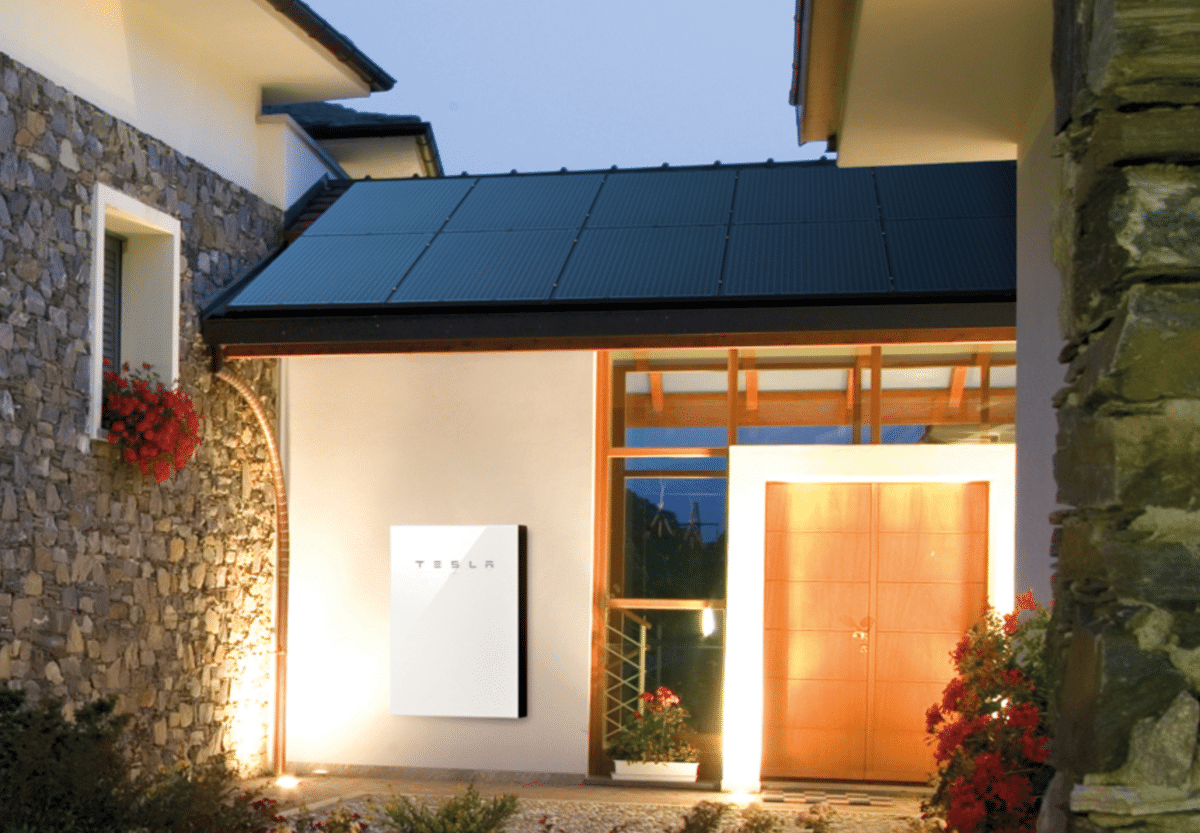The top three states with the most small-scale solar photovoltaic (PV) capacity at the end of 2020 were California (10.6 GW), New Jersey (1.9 GW), and Massachusetts (1.8 GW).
Of the 4.5 GW of small-scale solar capacity added in the United States in 2020, California accounted for 31%, the largest share by far.
And although Texas and Florida have less total small-scale solar capacity than either California or New Jersey, capacity has grown rapidly in recent years. In 2020, Texas added 422 MW of small-scale solar, and Florida added 282 MW. State incentives, strong solar resources, and policy changes are largely driving these gains.
The rankings were reported by the Energy Department’s Energy Information Administration (EIA), which defines “small scale” as any installation that is connected to the grid and is less than 1 MW in size.

New Jersey, New York, and Massachusetts are leaders for small-scale solar capacity despite having less favorable solar resources. In these states, long-standing state policies such as renewable and clean energy standards and other incentives, some of which include specific provisions for solar, encourage small-scale solar capacity growth.
Removing restrictions on leased solar systems has encouraged small-scale solar growth in Florida. Until April 2018, the Florida Public Service Commission restricted electricity sales from leased solar systems. Without that restriction, electricity customers can now lease solar systems with little or no upfront costs, making solar PV more widely economic and resulting in big growth. In 2020, small-scale solar capacity there grew 57%, from 492 MW in 2019 to 773 MW.
Although not in the top states for total small-scale solar capacity, Illinois added 309 MW of small-scale solar capacity in 2020, the third-highest number of additions, according to EIA. The additions doubled small-scale solar capacity in the state from 206 MW in 2019 to 515 MW in 2020.
Construction revolver for DSD
Distributed Solar Development (DSD) secured a two-year, $150 million construction revolver with Rabobank, a global food and agribusiness bank. The money will finance Distributed Solar’s pipeline of solar projects in the commercial and industrial (C&I) market.
The revolver follows a $300 million debt facility that DSD closed with Credit Suisse in late January. The revolver incorporates multiple tax equity partnerships and is designed to deliver capital through DSD’s business cycle, including an equipment supply sub-limit.
Spanish language loan products
Sunlight Financial said it is adding Spanish language loan products to enhance its technology platform, Orange. The move is aimed at further expanding solar to potential customers that have had difficulty accessing the market because of language barriers.
Sunlight is a point-of-sale finance company that works with contractors nationwide to provide homeowners with financing to install residential solar systems and other home improvements.
In late January, Sunlight agreed to combine with Spartan Acquisition Corp. The combined public company will be named Sunlight Financial Holdings Inc., and Sunlight’s existing management team will continue to lead the business.
What’s up with wind?
In both 2019 and 2020, U.S. project developers installed more wind power capacity than any other generating technology. Data from the EIA’s Preliminary Monthly Electric Generator Inventory said that annual wind turbine capacity additions set a record in 2020, totaling 14.2 GW, surpassing the previous record of 13.2 GW added in 2012. Total wind turbine capacity now stands at 118 GW.
This content is protected by copyright and may not be reused. If you want to cooperate with us and would like to reuse some of our content, please contact: editors@pv-magazine.com.









By submitting this form you agree to pv magazine using your data for the purposes of publishing your comment.
Your personal data will only be disclosed or otherwise transmitted to third parties for the purposes of spam filtering or if this is necessary for technical maintenance of the website. Any other transfer to third parties will not take place unless this is justified on the basis of applicable data protection regulations or if pv magazine is legally obliged to do so.
You may revoke this consent at any time with effect for the future, in which case your personal data will be deleted immediately. Otherwise, your data will be deleted if pv magazine has processed your request or the purpose of data storage is fulfilled.
Further information on data privacy can be found in our Data Protection Policy.